Posts filed under ‘Ancient Empires’
Ankara
The bus to Ankara turned out to be a bit more exciting than we had planned. The driver claimed he didn’t know he had to stop in Ankara on his way to Istanbul, so insisted on passing the exits. After a series of phone calls, and some remarkably polite and persistent intervention from Yekta, we arrived somewhere–anywhere–in Ankara and got off the bus. We managed to find four taxis despite the late hour (1:30 am) and made our way to the dorms at Bilkent University.
When our planned speaker postponed the next morning, I offered the students a day off to explore Ankara. Instead, they wanted to go out to Gordion, a site where UNC Classics Professor Ken Sams leads an excavation. After taxi, dolmus, and bus rides, we found ourselves looking up at a mound that had previously been a city.
 I loved Ken Sams’ discussion. We had encountered many guides who provided details about the stones. Ken is a historian. He told us what is known about the people who had lived at Gordion, how we know the things we know about them, and what we don’t know yet. As we stood looking into the stone walls between structures, he told us that the same things had been found in each. These implements provided information on food and textile manufacturing technology, but not why the same things had been found in each room. Archaeologist still don’t know who did the production, and how labor was organized.
I loved Ken Sams’ discussion. We had encountered many guides who provided details about the stones. Ken is a historian. He told us what is known about the people who had lived at Gordion, how we know the things we know about them, and what we don’t know yet. As we stood looking into the stone walls between structures, he told us that the same things had been found in each. These implements provided information on food and textile manufacturing technology, but not why the same things had been found in each room. Archaeologist still don’t know who did the production, and how labor was organized.
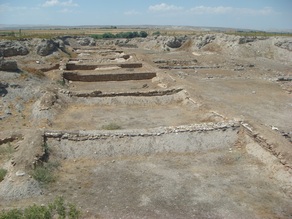 Ken explain to us the kinds of things archaeologists can know, what they wish they knew, why they think other kinds of records may no longer exist. And we learned that archaeologists sometimes revise their previous judgements. We visited the tomb of King Midas. Ken explained, though, that new dating suggested that the corpse was Midas’ father, making it still the tomb that Midas built, but not quite, well, the tomb in which he was buried.
Ken explain to us the kinds of things archaeologists can know, what they wish they knew, why they think other kinds of records may no longer exist. And we learned that archaeologists sometimes revise their previous judgements. We visited the tomb of King Midas. Ken explained, though, that new dating suggested that the corpse was Midas’ father, making it still the tomb that Midas built, but not quite, well, the tomb in which he was buried.
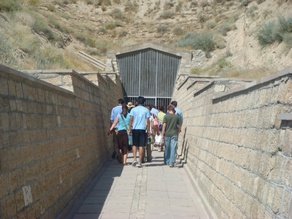
- Into the Tomb
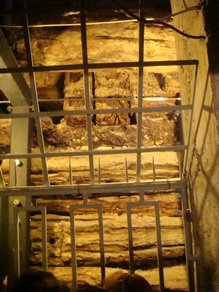
At the small museum next to the excavation, one of the graduate students working at the site explained that the local population had emulated Hellenistic pottery–it was quite the style in some circles. But they didn’t understand some of the Greek pottery’s particular functions, so their imitations are of great interest when analyzing cultural transmission. Ken had talked about the Greeks’ bringing their own languages and customs to Gordion–and to Anatolia generally–but both he and his student emphasized that the local, pre-Greek population remained present throughout the countryside. So what is a “Turk?” It was Phrygians who lived at Gordion–or anyway, it was a Phrygian government who ruled the people. And, it seems, the local population learned from the Greeks, but the Greeks also picked up some of the local customs.
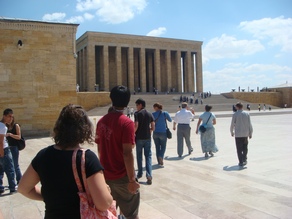
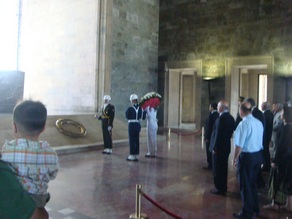
The second Ankara morning was devoted to Atatürk, of course. I got to stay at the dorms with an ill student while William took the students to Anıtkabir, Atatürk’s mausoleum and museum. Their guide was a friend’s father, a retired politician, former cultural minister, and a great admirer of the Founder. After reading of, talking about, and observing the Atatürk cult from afar, the students were able to get right to its center. I am sorry I missed it, but was delighted to hear about what the experience was like for them. (Check out their blogs, links on the right.)
By afternoon, everyone seemed well enough to go to the Museum of Anatolian Civilizations, where Thomas Zimmermann, archaeologist from Bilkent, talked to us about Turkey’s pre-history. He began outside, talking about the buildings themselves, how the project of taking Ottoman hans and turning them into an archaeological museum was an inherently political project. The goal was to claim a distinctly Turkish past, a past that predated the Ottomans, the Seljuks, and even the Byzantines. It reminded me of the new Lebanese state’s efforts to find its Phoenician past, and the nationalist Egyptians’ attempts to claim Pharonic origin. In this case, the new Turkish nationalists used archaeology to trace a very long historical trajectory, claiming that they descended from the Hattas and the Hittites.
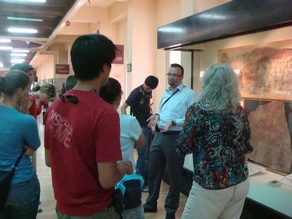
This is an award-winning museum, displayed well and labeled clearly, organized coherently and quite beautifully presented. It creates a linear historical path from pre-historical people to the Turkish present, almost ignoring the Greeks and Romans, who seem to be off limits– invaders instead of true inhabitants of the heartland. I found myself wondering how historians get to choose which groups are authentic and which are outsiders. But in any case, I think the students understand that there is much at stake in the project, more important than memorizing which artifacts go in which era.
Thomas’ fascination with metals was clear–it’s always exciting to have a teacher who is enthusiastic about his work.
Walking the King’s Road
Pamukkale to Eǧirdir was on a public bus, larger and more comfortable that what we had taken so far. It was much more conducive to sleep. I think these students need bus rides to sleep–they seem to be awake all the rest of the time.
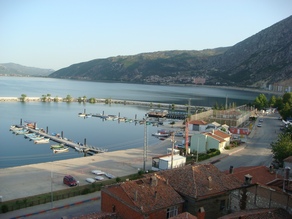
Eǧirdir sits on a large inland lake and is surrounded by spectacular mountains. It is on the way between places, which was our interest in coming. It sits close to the King’s Road that stretched from the Aegean to Persia in the fifth century BC. The Persians used the road for trade, Alexander the Great’s troops marched along it to conquer Darius II, and Paul walked it in his efforts to create converts. We arrived late in the afternoon, talked about Egirdir and history, then the students swam and we all explored the town and its neighboring islands.
 The next morning we went to one of Turkey’s national parks to walk part of the ancient road, now called “Yazılı Canyon,” or “with writing.” We looked at the Greek inscriptions on the hillside–and swam in the beautiful mountain river that created the valley. The setting is spectacular, the water is the sort of “mountain stream” that companies bottle and sell. The students seem always to be drawn to high places, and they followed their passion onto the rocks, from which they jumped into the ice cold water.
The next morning we went to one of Turkey’s national parks to walk part of the ancient road, now called “Yazılı Canyon,” or “with writing.” We looked at the Greek inscriptions on the hillside–and swam in the beautiful mountain river that created the valley. The setting is spectacular, the water is the sort of “mountain stream” that companies bottle and sell. The students seem always to be drawn to high places, and they followed their passion onto the rocks, from which they jumped into the ice cold water.
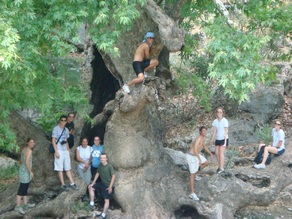

We were delighted to have the park to ourselves, but spent some time on the rocks talking as we dried off. What does it mean that no one was at the national park? Our own national parks are being inundated with tourists, crowded to the point where their resources are compromised. Where do Turks go for vacations? To whom does the Tourism Ministry direct itself? What is the role of tourism in creating a national identity?
As always, the students’ questions and comments were fascinating. Turkey seems to have a two-track tourism effort. For Turks, tourism is about recreation and about education. There is a pass costing only YTL 20 that allows Turks into all major historical and natural sites (unavailable to foreigners who pay admission fees everywhere.) For foreigners, tourism TV ads on European stations emphasize the exotic, the erotic, and the ancient. They left me considering whether, indeed, Turkey’s efforts to present herself as exotic to lure European tourists can possibly be reconciled with her attempts to portray herself as modern and eligible for EU membership.
Pamukkale
We were all sad to say goodbye to the guesthouse and Ephesus. We had had a terrific “day off,” and most of the students slept on the bus to try to catch up!


Pamukkale was the next stop. It is named after the white calcium cliffs that rise above the town. Its waters have been considered good for healing for centuries, and many before the Romans had built on top of the cliffs. After years as a major tourist site with a number of five-star hotels at the top, the UN declared the spot a World Heritage Site, insisted on removing the hotels, and revised the water supply so that the calcium-rich water continued to build up and repair the previous decades’ damage.
It is amazing to climb the hillside. It looks glacial, and I expected that, when I took off my shoes (required), my feet would be in icy water. It looks like ice, but feels quite warm. People played in the pools all the way up to the top, where a swimming pool beckons. You can “swim among the ruins,” the pillars and capitals and various ruins in the warm-water mineral-which swimming pool. Needless to say, the students swam.
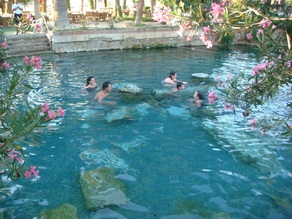
Before we headed up, I had provided a background to the site and to Hierapolis, the ruined city at the top of the hill. After the swimming pool closed, we walked to the Temple of Apollo and the Plutonium. I’d prepared information about six major buildings at the site, but the third was a theater with a stunning view of the countryside below– and a fantastic sunset. They climbed around the theater until it was dark, looking for the images I had asked them to find and enjoying the remarkable setting.
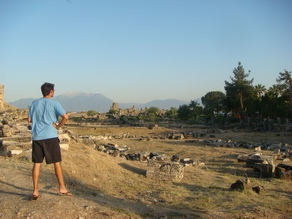
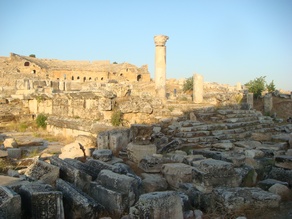
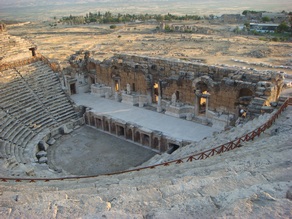
Needless to say, it was difficult to leave Pamukkale, too. I’ve never encountered a group like this. Each evening since we left Istanbul, they have declared it the best day yet. It’s hard not to be enamoured of that kind of attitude!
Ephesus
Our first two days had been grueling, and it had followed some very busy and intense final days preparing for the trip. Every seat on the Fez bus had been full, and none of the 27 seats had been very comfortable. Five hours of battle and battlefield descriptions had delighted only a few of us. The focus on details at the ancient sites had left many confused. The sun was hot, all of us tired, so we offered to let the students sleep late and spend a couple hours at the beach. They hadn’t had any days off in a long time!
We listed the things we could choose from in the area the next day, and asked them to decide what they wanted to see around Selcuk and Ephesus. They produced a schedule that began at 9 am and continued until 10 in the evening. I was impressed!
They were actually ready at 9 in the morning. The first stop: the house where the Pope confirmed that the Virgin Mary spent her last days. This is a small house on a beautiful hillside overlooking Ephesus. We followed a tour group from Italy into the small house. The students’ reactions were varied. Some were clearly touched by the devotion they witnessed, some by their own devotion. Most had never seen anything like the wall to which people were attaching their written prayers.
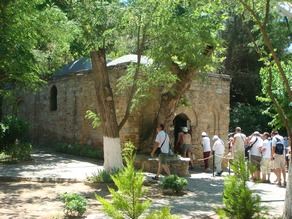
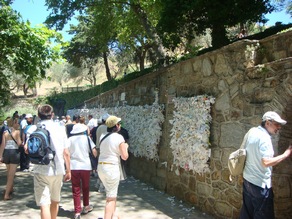
Then it was down the hill to Ephesus. As a historian, I am painfully aware of my own limitations. I’m always hesitant to repeat “general knowledge,” recognizing how inaccurate it often proves in my own field. So I had welcomed the notion of a tour guide, someone who knew the history of the places we were to visit.
But after three guided tours, I realized the the guides didn’t actually know the history of these places, either. They knew the details of the site. They couldn’t provide context, couldn’t describe the bigger picture, couldn’t explain the importance. I was missing the details, which I had thought were what I really needed to have to talk about these sites. But I realized that the details alone were not enough. And we had alreadt learned to ignore the tour guides. It was time to experiment.
I gave myself a crash course on Ephesus and the way the city grew and changed and moved and adapted to the varied challenges to its population. I did a 15-minute background, then turned the students loose in the most remarkable ancient city I’ve had the good fortune to visit. Clearly, this was not enough. They got the background, but that didn’t help them navigate the city. I walked out of the site again, bought a few copies of an inexpensive book explaining the ruins, and distributed them.

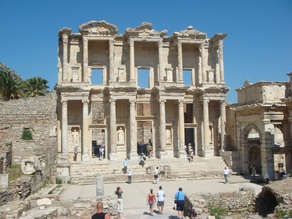
This group is very bright, extremely motivated. With the help of the map and a few of the descriptions, they did a great job showing themselves around Ephesus. They had a broader context, a map to help them figure out where they were, and the details if they wanted them. Nonetheless, I had a sense that I hadn’t provided all they needed. (How much should I provide?) I still have to work on combining teacher and tour guide. Maybe there is something between providing basic background and providing overwhelming detail. I think next time I would send them with a set of questions to find answers to in the ruins.

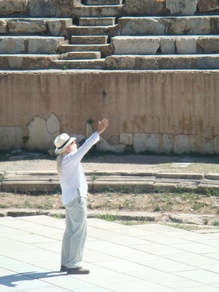 William orating
William orating
The day continued at their pace. The Ephesus museum followed the site visits, then lunch with a friend of Emily’s family in the beautiful garden of a carpet-weaving school. We talked with one of the owners. They bring girls from the nomadic villagers to teach them to weave (why do they need to be taught in the city?). The course takes 40 days, after which each girl is given a loom and sent home. I asked whether the girls could then sell only to this establishment. No. Why do they? The owner answered that he pays the girls directly, not their fathers or their brothers. That keeps them coming back to sell to him.
I took a “break” (gotta research the next site!) while William and the students went to Pamucak beach nearby. Ephesus used to be at the coast, but persistent silting was one of the reasons for its demise. Now the beach is 7 kilometers away, and provided a wonderful (cooling!) outlet for the students’ boundless energy.
After a very short time back in the pensiyon, we went up the hill to the “Greek” village at the top. We wandered the streets, tasted the various fruit wines, talked with some of the residents, and tried to figure out whether there were any Greeks left, and what Greek might mean in this context.
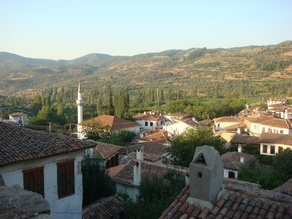
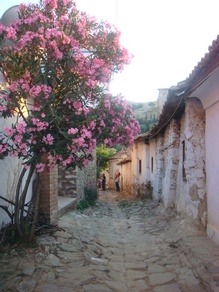
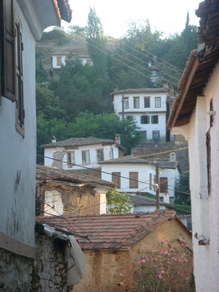
A Day Off, UNC-student style!